Related Research Articles
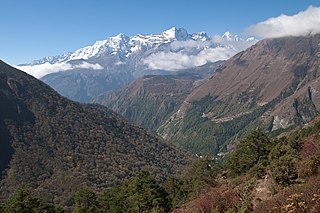
Sagarmāthā National Park is a national park in the Himalayas of eastern Nepal that was established in 1976 and encompasses an area of 1,148 km2 (443 sq mi) in the Solukhumbu District. It ranges in elevation from 2,845 to 8,848 m and includes Mount Everest. In the north, it shares the international border with Qomolangma National Nature Preserve in Tibet Autonomous Region. In the east, it is adjacent to Makalu Barun National Park, and in the south it extends to Dudh Kosi river. It is part of the Sacred Himalayan Landscape.
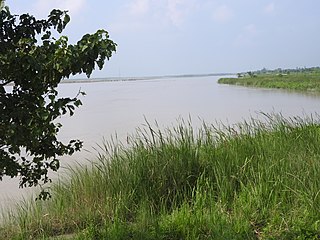
The Koshi Tappu Wildlife Reserve is a protected area in the Terai of eastern Nepal covering 176 km2 (68 sq mi) of wetlands in the Sunsari, Saptari and Udayapur Districts. It comprises extensive reed beds and freshwater marshes in the floodplain of the Kosi River, and ranges in elevation from 75 to 81 m. It was established in 1976 and designated as a Ramsar site in December 1987. It hosts Nepal's last remaining herd of the wild water buffalo.

The Terai–Duar savanna and grasslands is a narrow lowland ecoregion at the base of the Himalayas, about 25 km (16 mi) wide, and a continuation of the Indo-Gangetic Plain in India, Nepal and Bhutan. It is colloquially called Terai in the Ganges Basin east to Nepal, then Dooars in West Bengal, Bhutan and Assam east to the Brahmaputra River. It harbours the world's tallest grasslands, which are the most threatened and rare worldwide.

Bardiya National Park is a protected area in Nepal that was established in 1988 as Royal Bardia National Park. Covering an area of 968 km2 (374 sq mi) it is the largest and most undisturbed national park in Nepal's Terai, adjoining the eastern bank of the Karnali River and bisected by the Babai River in the Bardiya District. Its northern limits are demarcated by the crest of the Siwalik Hills. The Nepalgunj-Surkhet highway partly forms the southern boundary, but seriously disrupts the protected area. Natural boundaries for human settlements are formed in the west by the Geruwa, a branch of the Karnali River, and in the southeast by the Babai River.

The Kosi or Koshi is a transboundary river which flows through China, Nepal and India. It drains the northern slopes of the Himalayas in Tibet and the southern slopes in Nepal. From a major confluence of tributaries north of the Chatra Gorge onwards, the Kosi River is also known as the Saptakoshi for its seven upper tributaries. These include the Tamur River originating from the Kanchenjunga area in the east and Arun River and the Sun Kosi from Tibet. The Sun Koshi's tributaries from east to west are the Dudh Koshi, Likhu Khola, Tamakoshi River, Bhote Koshi and Indravati. The Saptakoshi crosses into northern Bihar, India where it branches into distributaries before joining the Ganges near Kursela in Katihar district. The Kosi is the third-largest tributary of the Ganges by water discharge after the Ghaghara and the Yamuna.

Rara Lake, also known as Mahendra Lake, is the largest fresh water lake in the Nepalese Himalayas. It is the main feature of Rara National Park, located in Jumla and Mugu Districts of Karnali Province. Rara National Park stretches over 106 km2 (41 sq mi).

The Eastern Himalayan broadleaf forests is a temperate broadleaf forest ecoregion found in the middle elevations of the eastern Himalayas, including parts of Nepal, India, Bhutan, Myanmar and China. These forests have an outstanding richness of wildlife.
Shey Phoksundo National Park is the largest and only trans-Himalayan national park in Nepal. It was established in 1984 and covers an area of 3,555 km2 (1,373 sq mi) in the districts of Dolpa and Mugu in the Mid-Western Region, Nepal. The protected area ranges in elevation from 2,130 to 6,885 m. Phoksundo Lake is the park's prominent feature, located at an elevation of 3,612 m (11,850 ft).

Phoksundo Lake (Nepali: फोक्सुण्डो, romanized: Phoksuṇḍo, pronounced ) is an alpine fresh water oligotrophic lake in Nepal's Shey Phoksundo National Park, located at an elevation of 3,611.5 m (11,849 ft) in the Dolpa District. Phoksundo Lake is 494 ha (1.91 sq mi) in size with a water volume of 409,000,000 m3 (1.44×1010 cu ft) and a discharge of 3.715 m3/s (131.2 cu ft/s). In 2004, a survey by the Department of Hydrology and Meteorology measured the maximum depth of the lake at 145 m (476 ft). In 2019, another detailed survey was carried out by the Department of Hydrology and Meteorology, which measured the maximum depth of the lake at 136.20 m (446.9 ft).
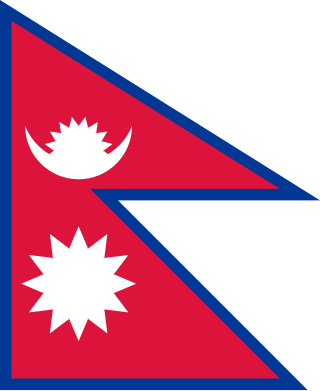
The following outline is provided as an overview of and topical guide to Nepal:

Rara National Park is a protected area in the Himalayas of Nepal and was established in 1976. Covering an area of 106 km2 (41 sq mi) in the Mugu and Jumla districts, it is the country's smallest national park. Its main feature is Rara Lake at an altitude of 2,990 m (9,810 ft). The park was established to protect the unique flora and fauna of the Humla–Jumla Region of Nepal.

Langtang National Park is a national protected area in north-central Nepal. It was established in 1976 as Nepal's first Himalayan national park and the country's fourth protected area. It covers an area of 1,710 km2 (660 sq mi) in the Nuwakot, Rasuwa and Sindhulpalchok Districts of the central Himalayan region. It contains 26 village communities and includes the Langtang valley. In the north and east it is linked with Qomolangma National Nature Preserve in the Tibet Autonomous Region. The eastern and western boundaries follow the Bhote Koshi and the Trishuli river, respectively.

Shuklaphanta National Park is a national park in the Terai of the Far-Western Region, Nepal, covering 305 km2 (118 sq mi) of open grasslands, forests, riverbeds and wetlands at an elevation of 174 to 1,386 m. It is bounded by the Mahakali river in the west and south. A small part extends north of the Mahendra Highway to create a wildlife corridor for seasonal migration of wildlife into the Sivalik Hills. It was gazetted in 1976 as Royal Shuklaphanta Wildlife Reserve and was enlarged to its present size in the late 1980s. A buffer zone of 243.5 km2 (94.0 sq mi) was added in 2004. It receives a mean annual rainfall of 1,579 mm (62.2 in) and harbours 700 floral, 456 bird, 56 reptile and 15 amphibian species.
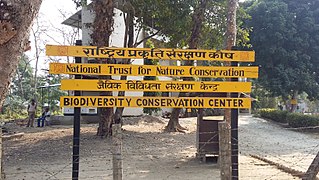
The National Trust for Nature Conservation (NTNC),, previously known as King Mahendra Trust for Nature Conservation, is a Nepalese autonomous and not-for-profit organization working in the field of nature conservation.

Banke National Park is located in the Lumbini Province and was established in 2010 as Nepal’s tenth national park after its recognition as a "Gift to the Earth". The protected area covers an area of 550 km2 (210 sq mi) with most parts falling in the Sivalik Hills. The park is surrounded by a buffer zone of 344 km2 (133 sq mi) in the districts of Banke, Salyan and Dang Deukhuri Districts.

The Manaslu Conservation Area is a protected area in Nepal. Established in 1998, it covers 1,663 km2 (642 sq mi) in the Mansiri Himal range of the Himalayas in the Gorkha District. The area comprises mountains, glaciers, and watercourses. In elevation, the area ranges from 1,400 to 8,156 m, the highest point being the peak of Manaslu.

Kanchenjunga Conservation Area is a protected area in the Himalayas of eastern Nepal that was established in 1997. It covers 2,035 km2 (786 sq mi) in the Taplejung District and comprises two peaks of Kanchenjunga. In the north it adjoins the Qomolangma National Nature Preserve in Tibet, and in the east the Khangchendzonga National Park in Sikkim. To the west it borders the Sankhuwasabha District. It ranges in elevation from 1,200 to 8,586 m. It is part of the Sacred Himalayan Landscape, which is being developed by WWF Nepal in partnership with the International Centre for Integrated Mountain Development.

The Blackbuck Conservation Area is located in Gulariya, Bardiya District, Nepal and was established in 2009 to conserve the endangered blackbuck. This protected area covers 16.95 km2 (6.54 sq mi).
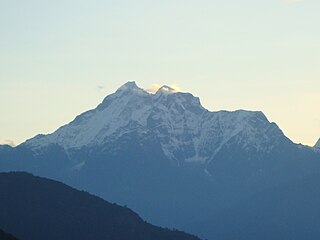
Gaurishankar Conservation Area is a protected area in the Himalayas of Nepal that was established in January 2010, covering 2,179 km2 (841 sq mi) in the Ramechhap, Dolakha and Sindhupalchok districts and encompassing 22 Village Development Committees. It is contiguous with Tibet in the north and a part of the Sacred Himalayan Landscape. The protected area connects the Langtang and Sagarmatha National Parks. In 2010, the Government of Nepal handed over the management of Gaurishankar Conservation Area to National Trust for Nature Conservation for 20 years, which has been managing the area through its Gaurishankar Conservation Area Project.

The Api-Nampa Conservation Area is a protected area in the western Nepal that was established in 2010. It has an area of 1,903 km2 (735 sq mi). It ranges in elevation from 518 to 7,132 m at the Himalayan peak Api, and is part of the Kailash Sacred Landscape.
References
- ↑ Bhuju, U. R.; Shakya, P. R.; Basnet, T. B.; Shrestha, S. (2007). Nepal Biodiversity Resource Book. Protected Areas, Ramsar Sites, and World Heritage Sites (PDF). Kathmandu: International Centre for Integrated Mountain Development, Ministry of Environment, Science and Technology, in cooperation with United Nations Environment Programme, Regional Office for Asia and the Pacific. ISBN 978-92-9115-033-5. Archived from the original (PDF) on 2011-07-26. Retrieved 2024-05-02.
- ↑ Bhushal, R. P. (2010). "Nod to Banke National Park". The Himalayan Times. Kathmandu. Archived from the original on 2014-12-18. Retrieved 2024-05-02.
- ↑ Chaudhary, H.; Poudyal, L.P. (2016). Bird Survey of Api Nampa Conservation Area in Nepal, 2016: Report to the Api Nampa Conservation Area Office, Khalanga, Darchula, Nepal (Report). Kathmandu, Nepal: Nepalese Ornithological Union and Department of National Parks and Wildlife Conservation. Archived from the original on 2018-10-08. Retrieved 2024-05-02.
- ↑ NTNC (2010). Gaurishankar Conservation Area Project (Report). Kathmandu, Nepal: National Trust for Nature Conservation. Archived from the original on 2018-12-04. Retrieved 2024-05-02.
- ↑ DNPWC (2014). Blackbuck Conservation Area (Report). Kathmandu: Department of National Parks and Wildlife Conservation. Archived from the original on 2015-01-28. Retrieved 2024-05-02.
- ↑ Prasad, Madhav (2016-04-08). "Top Must See Places in Bhutan". Mosaic Adventure. Archived from the original on 2023-06-25. Retrieved 2023-06-27.
- 1 2 Bhandari, B. B. (2009). "Wise use of Wetlands in Nepal". Banko Janakari. 19 (3): 10–17.
- ↑ "DNPWC". Department of National Parks and Wildlife Conservation. Archived from the original on 2020-02-18. Retrieved 2024-01-04.
- ↑ Baral, S.; Dhakal, M.; Khanal, R. (2016). Lake Cluster of Pokhara Valley. Kathmandu: Department of National Parks and Wildlife Conservation, IUCN Nepal. Archived from the original on 2023-06-10. Retrieved 2024-05-02.